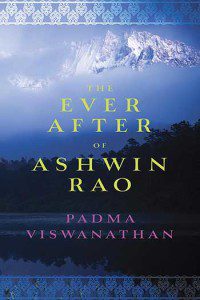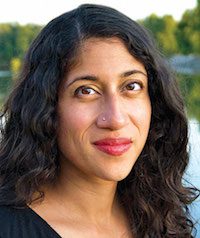
Ashwin Rao, the solitary, emotionally detached psychologist in Padma Viswanathan’s ruminative new novel, The Ever After of Ashwin Rao, practices an esoteric variety of psychotherapy known as narrative therapy in New Delhi. His patients tell him their troubles and he writes their accounts as stories, holding a mirror up to the psychically wounded in an effort to lead them toward transformation. The book opens in 2004 with Ashwin leaving India to research a book on grief in Canada, where he intends to interview families who lost loved ones in the bombing of an Air India flight from Montreal almost 20 years earlier. Ashwin does not disclose to his subjects that his sister Kritika and her school-age children, his beloved niece and nephew, perished in the same tragedy. Yet the prospect of finding out “by what means” others have coped with sudden, devastating loss—presumably better than he has—jolts Ashwin out of his own malaise, his “paralyzing fog” of self-doubt and inaction.
Viswanathan, a Canadian writer of Indian heritage, published the book to acclaim last year in Canada, where it was short-listed for the prestigious Giller Prize. It follows her much-admired first novel, The Toss of A Lemon (2008), which documents the constricted life of an orthodox Tamil Brahmin family in southern India across the 20th century, a portrait of anthropological detail that Viswanathan composed over a decade, based on stories she collected from her grandmother and others.
The Ever After of Ashwin Rao circles around a horrific event that occurred during Viswanathan’s own youth, a terrorist act that remains the worst incidence of mass murder in Canadian history. In June 1985, Sikh militants based in Canada targeted Air India, the national carrier, in their battle against the Indian government for an independent homeland. All 329 people on board—the vast majority of them Indian immigrants to Canada—were killed as the 747 exploded over the Irish Sea.
The attack is a sensitive, even shameful topic for Canadians. Indifferent authorities bungled the investigation of an act of homegrown terrorism, taking almost twenty years to bring just two conspirators to trial. A nation lodged in the racism of the era did not mourn or even acknowledge the brown-skinned victims.
I was an intern in Air India’s New York office that summer and remember the anguished voices of managers as details of the plane’s disappearance emerged. A pall of stunned despair settled over the office. When death strikes without warning, like a flash of lightning in the dark, survivors are forced to reckon with their own powerlessness. But the habit of being in control is hard to shake. As soon as the passenger manifest was released, I tucked a telex copy into a manila folder, all 329 names of the dead, as if that might save them from oblivion.
Over the years, though, my recollection of the information I collected grew hazy. Only recently did I discover the folder buried in the back of a filing cabinet. But, as Viswanathan shows, for family members and close friends of victims, there is no forgetting the consequences of a single moment. The violent death of loved ones becomes a life sentence.
“I had not recovered. Did anyone, from so severe a blow?” Ashwin ponders upon interviewing Kritika’s husband, who has recently remarried. “Perhaps not, but I had, in some way, stopped my life.” The men’s reunion in Montreal, after many years, is otherwise matter-of-fact and unmoving, a letdown for the reader who hopes for a glimpse beneath Ashwin’s guarded exterior. He is both emotionally bottled up and overflowing with criticism, injecting arch remarks about Indian society and politics into his personal reflections. For instance, he discloses that he had a vasectomy immediately after his sister’s death with a flip joke about overpopulated India, but he offers no thoughts on why he has denied himself the possibility of children. As a therapist, Ashwin declares he can worm his way into any mind, using narrative as an instrument of insight. But he appears incapable of divining his own motives and holds out hope that writing his book will lead to self-understanding.
The premise that Ashwin’s pilgrimage among the bereaved might be a journey to enlightenment is an intriguing opening. Yet we do not follow his peregrinations across Canada or witness any drama around the trial of the two accused terrorists, which is underway in Vancouver. Instead the novel centers on Ashwin’s prolonged visits to a picturesque mountain town in British Columbia, Lohikarma, where two Indian families have been severely impacted by the long-ago tragedy. Venkat, a math professor who lost his wife and college-age son in the bombing, has grown belligerent and unstable over the years, turning to right-wing Hindu politics. Ashwin finds him repulsive, but becomes enchanted with his friend Seth, a fellow academic at the local university, who acts as Venkat’s emotional caretaker, assuming responsibility for a man who has no one left.

As warm and congenial as Venkat is furiously bitter, Seth, too, has been fundamentally altered by his proximity to loss. Gripped by fear for his own family’s wellbeing, he finds consolation in a Hindu religious cult, Shivashakti, which has a devoted following in a town given to alternative lifestyles. For the orphaned Ashwin (his parents have passed away too), Seth, along with his wife and their adult daughter, Brinda, offer a surrogate family he can attach himself to.
The air of mystery around the tragic experiences of these “living victims” in Lohikarma infuses Ashwin’s interviews with the promise of revelation. How did they respond to the shock of the news? What extremes of pain do they know that we do not? We sit in on a few initial conversations between Ashwin and his subjects, and then Viswanathan reconfigures the novel. Ashwin loses his position as the novel’s anchor, narrating the story in his own voice, and an omniscient voice we don’t recognize arises to tell us about the lives of Seth and, to a lesser extent, the unhappily married Brinda.
Venkat, the primary victim of the tragedy, is reluctant to talk, and Ashwin condemns his Hindu fundamentalist politics without trying to investigate that rage as a reaction to Sikh terrorism. In the overblown manner of caricature, Viswanathan fashions Venkat into a kind of effigy of the social evils of India—a man defined by chauvinism, sexism and sectarianism. He has even taught his parakeets to spout jingoistic, pro-Hindu slogans.
In the stories about Seth and his family, Ashwin plays no role, has no active presence and exists, apparently, only as the invisible scribe. It becomes hard to find one’s bearings as the novel jumps between Ashwin’s continuing, first-person narrative and these sudden landings in Seth’s past or present. But it is compelling to spy on tragedy unfolding in someone else’s life, to watch how Seth comforts Venkat in the hours following the news of his wife and son’s deaths; how they travel together to Ireland to claim the bodies; how he saves a distraught Venkat from suicide. Ashwin makes no mention of writing these stories, so we can only presume he has collected the information during further interviews with Seth and not merely transcribed them but rendered them with all the imaginative powers of a novelist. Other people’s voices possess him, he tells us at one point, and he needs to purge them into his journal, out of his head.
Ashwin’s dilemma as a man locked inside himself is poignant. The irony of his being able to connect to others on paper while being emotionally divided from people applies to some writers as well. Seth’s presence warms this distant man with his cerebral defense mechanisms, awakening him to his human need for love. Renewed desire leads him back to a Canadian woman with whom he’d had a long relationship when he lived in Canada as a young man, before leaving to attend to his ailing father in India.
The stories from Seth’s life (and Brinda’s) are a puzzle, rendered with a wealth of detail that could not possibly have emerged in interviews and must have been invented by Ashwin. It makes us wonder how much of the story we are being told about Seth is true and how much imagined. Seth, a conservative Brahmin man, would not have disclosed to Ashwin his intimate sexual gestures toward his wife, or even how he imagined the plane blowing apart, moment by moment. Here it seems like Viswanathan is giving us a glimpse of the novelist’s talents, of how she might have constructed her first novel, weaving a narrative of tremendous imagined specificity out of stories others told her. Ashwin animates Seth’s life for us, without giving himself away in the story.
His metamorphosis from a man seeking to understand grief to a fiction writer is a conundrum of the novel and the fundamental source of its incoherence. It seems to me the story would have been better served if Viswanathan had shown us how Ashwin grappled with the information Seth or Brinda divulged to him in conversation, how he digested it, compared their experiences to his own. In what ways did he struggle to understand Seth? Or Brinda, whose life is devoid of sex like his? What did he learn about himself through them? We never observe his process of emotional and intellectual discovery, which is what writing is. If we had been privy to his thoughts as he labored to figure things out, there would have been a connection among all the stories, which there isn’t now.
So, perhaps the book is not quite the examination of grief it purports to be. In important ways that are destructive to Ashwin’s story, Viswanathan’s second novel seems to be locked in dialogue with her first, despite their vastly different settings in Canada and India. In The Toss of a Lemon, the culture of a rigid, tyrannical Brahmin patriarchy in a Tamil village profoundly oppresses Sivakami, a teenage widow who is forbidden to show her face in public and forced to live indoors. Viswanathan, as the omniscient narrator, painstakingly documents her thwarted life. In The Ever After of Ashwin Rao, there is payback against a brutal old Indian patriarchy. This time it is a domineering Brahmin patriarch, Venkat, who is punished with widowhood and, moreover, denied our sympathy for his loss, because of his bigoted politics. He is even denied a voice in the story, almost everything we know about him mediated by Seth.
Unfortunately, neither Ashwin’s loneliness nor Seth’s spiritual distress generate the kind of galvanizing drama this diffuse story needs at its center, a crisis that would fully engage us in the characters’ lives. What is at stake here? Only Venkat seems in real danger, teetering on the brink of madness, but he is dismissed as a zealot. A flux of ideas and events distract us, dispersing narrative energy—tropes like Schrodinger’s cat from the realm of physics, diatribes against the Indian state, even a whacky monologue from the point of view of the terrorists’ bombs. If the center doesn’t hold, it could be because the wild figure who might occupy that space—Venkat—has been sidelined for his wickedness. He is the only character who goes back to India, with all its injustices and cruelties enumerated by Ashwin. A moral is served—only corrupt Indians choose India over the West—in a wobbly vessel made of fragments.




